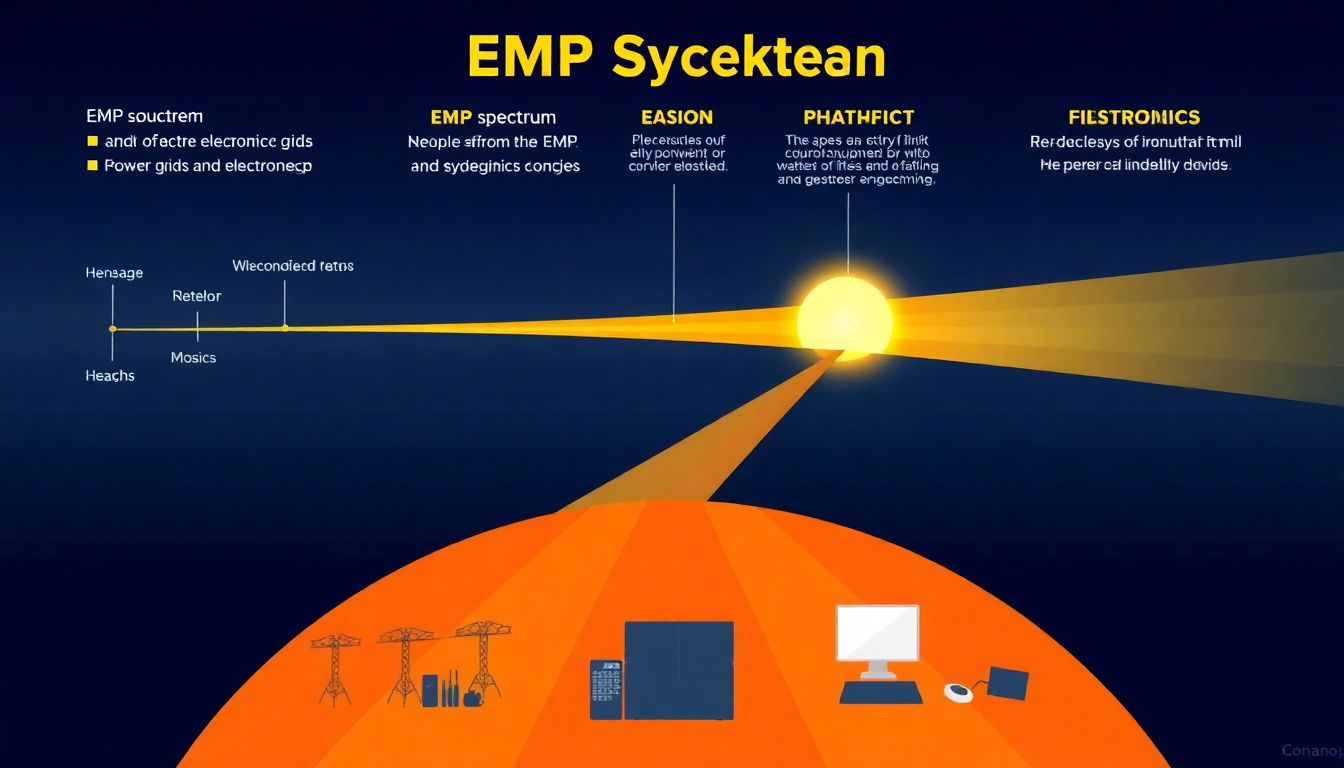Have you ever wondered what would happen if a powerful electromagnetic pulse (EMP) were to strike our modern, tech-reliant world? What if, in an instant, every electronic device within a vast radius was rendered useless, from smartphones to cars, and even the power grid itself? This chilling scenario, once the realm of science fiction, is now a very real concern for governments and individuals alike. According to a report by the U.S. Department of Energy, a powerful EMP event could leave up to 90% of the U.S. population without power for months, if not years. But what if you could be prepared? What if you could protect your most vital electronics and ensure they’re ready to serve you when the lights go out? Welcome to ‘The Prepper’s Guide to Surviving an EMP Attack: Protecting Your Electronics’.
In this comprehensive guide, we promise to equip you with the knowledge and tools necessary to safeguard your electronic devices from the devastating effects of an EMP. We’ll delve into the science behind EMPs, explore real-life examples, and provide practical, step-by-step instructions to help you build your own EMP-proof Faraday cages. But first, let’s address the elephant in the room: why should you care about EMP attacks?
In today’s interconnected world, our reliance on electronics is profound. From communication and navigation to banking and healthcare, our daily lives are intertwined with technology. An EMP attack, whether natural or man-made, could disrupt these systems, leaving us isolated and vulnerable. But it doesn’t have to be that way. With the right preparation, you can ensure that your most critical electronics are ready to serve you when the grid goes down. So, are you ready to take the first step towards EMP attack survival and grid-down preparedness? Let’s dive in and explore the fascinating world of electronic protection.
Electronic Protection Strategies for Grid-Down Preparedness
In the face of potential power grid disruptions, be they caused by natural disasters, cyber threats, or other unforeseen circumstances, it’s crucial to have a robust electronic protection strategy in place. This is where grid-down preparedness comes into play, ensuring that our essential electronic devices remain functional and accessible even when the power grid fails. Imagine, if you will, a world where your refrigerator, water purifier, and communication devices continue to operate seamlessly, even as the rest of the neighborhood is plunged into darkness. The key to this is a multi-layered approach that combines the use of renewable energy sources, such as solar or wind power, with advanced energy storage systems like batteries. These systems can be designed to provide immediate backup power, ensuring that your critical devices remain operational during outages. Additionally, investing in Uninterruptible Power Supply (UPS) systems can provide an extra layer of protection, ensuring that your devices are not only powered but also safeguarded from power surges and fluctuations. Moreover, it’s essential to consider the use of power management software and smart home technologies that can optimize energy usage and maximize the lifespan of your backup power sources. By implementing these electronic protection strategies, you’re not only preparing for grid-down scenarios but also contributing to a more sustainable and resilient future. So, why wait? Start planning your grid-down preparedness strategy today and ensure that you’re always one step ahead, no matter what challenges the future may bring.

Understanding EMP Attacks
Imagine you’re in a room filled with electronic devices
- smartphones, laptops, smart TVs, and even your trusty old toaster. Now, picture a powerful, invisible force suddenly sweeping through the room, instantly frying every single one of these devices. That, in simple terms, is what an Electromagnetic Pulse (EMP) attack does. It’s like a giant, invisible hand that reaches out and turns off every electronic device in its path.
EMPs can occur naturally, like during a solar flare, or they can be man-made, created by detonating a nuclear weapon high in the atmosphere. But don’t worry, we’re not talking about something that happens every day. In fact, the last naturally occurring EMP was in 1859, and it caused some serious trouble with the telegraph systems of the time.
Now, you might be wondering what an EMP attack would do to our modern infrastructure. Well, it’s not pretty. In the immediate aftermath, every electronic device within the pulse’s range would stop working. That includes cars, traffic lights, hospitals’ life-support systems, and even the power grid itself. It’s like going back to the Dark Ages, but with the added challenge of having no way to communicate with each other.
But the effects don’t stop there. Even if some infrastructure manages to survive the initial blast, the lack of power could cause long-term damage. Pipelines could burst without the pumps to keep them pressurized, water treatment plants could fail, leading to contaminated water supplies, and food spoilage could become a major issue. It’s a daunting prospect, but understanding EMP attacks is the first step in preparing for them. After all, knowledge is power, even when the lights go out.

The Faraday Cage: Your First Line of Defense
Imagine you’re in the middle of a storm, and suddenly, a bolt of lightning strikes nearby. Your heart races, but you’re safe because you’re inside a Faraday cage
- an invisible shield that protects you from the electrical discharge. This is the same principle that protects your electronics from electromagnetic pulses (EMPs), which can fry circuits and render devices useless. A Faraday cage is essentially a conductive enclosure that redirects electrical charges around an object, preventing them from entering. In the context of EMPs, it’s your first line of defense against potential electronic Armageddon.
Building a Faraday cage at home is surprisingly simple and can be done using common materials. The key is to create a continuous, conductive barrier. Here’s a step-by-step guide using a metal trash can as an example:
- Choose a metal container with a tight-fitting lid. The larger the container, the more devices it can protect.
- Line the inside of the container with aluminum foil, ensuring there are no gaps. The foil should also cover the lid and extend over the edges to create a seamless barrier.
- Place your electronic devices inside the container. Make sure they’re not touching the sides to maintain a small air gap.
- Securely close the lid. The container should now be fully enclosed, with no gaps or holes.
To maximize the effectiveness of your Faraday cage, consider these tips:
- Use a metal container with a low carbon content, as this conducts electricity better.
- Avoid using containers with plastic handles or non-conductive coatings.
- Regularly check for any punctures or tears in the foil lining.
- For added protection, you can nest multiple Faraday cages together.
While a homemade Faraday cage won’t protect your electronics from a direct lightning strike or a powerful EMP, it can provide valuable protection against smaller electromagnetic pulses. It’s a simple, cost-effective way to safeguard your devices in an uncertain world.

Hardening Your Electronics: Beyond the Faraday Cage
In the realm of electronic warfare and natural phenomena, protecting your devices from Electromagnetic Pulse (EMP) events is not just a matter of wrapping them in a Faraday cage. While Faraday cages offer excellent shielding, they’re just the first line of defense in a comprehensive strategy. Let’s delve into additional measures to harden your electronics against EMPs.
Firstly, consider the role of surge protectors. These devices are designed to safeguard your electronics from sudden, unexpected power surges. When an EMP strikes, it can induce high voltages in power lines, making surge protectors an essential first step in your defense strategy. They work by diverting excess voltage to the ground, protecting your sensitive electronics from damage.
Next, voltage regulators play a crucial role in maintaining a consistent power supply to your devices. EMPs can cause voltage fluctuations, which can fry your electronics if they’re not properly regulated. Voltage regulators ensure that your devices receive a steady, safe power supply, even in the face of an EMP.
Shielded cables are another line of defense. These cables are designed to protect the signals they carry from electromagnetic interference. By using shielded cables, you can reduce the risk of EMP-induced noise and interference reaching your sensitive electronics.
Proper grounding is also vital. A good grounding system can help to dissipate excess charge and voltage, protecting your electronics from EMP-induced surges. Ensure that your grounding system is well-maintained and up to code to provide maximum protection.
Lastly, transient voltage suppressors (TVS) are a powerful tool in your EMP defense arsenal. TVS devices are designed to absorb and dissipate excess voltage, protecting your electronics from voltage spikes. They’re particularly useful in protecting sensitive components like microcontrollers and integrated circuits.
In conclusion, while Faraday cages offer excellent shielding, they’re just one part of a comprehensive strategy to harden your electronics against EMPs. By using surge protectors, voltage regulators, shielded cables, proper grounding, and transient voltage suppressors, you can create a robust defense system to protect your sensitive electronics from these powerful pulses.

Backup Power Options for Grid-Down Scenarios
When the grid goes down, having a reliable backup power source can make all the difference. Let’s explore three primary backup power options, their pros and cons, EMP protection compatibility, and how to integrate them into your preparedness plan.
The first option is generators, which come in various types: portable, standby, and inverter. Portable generators are affordable and versatile, running on gasoline or propane. They’re great for powering essential appliances during short-term outages. However, they’re noisy, produce emissions, and require regular maintenance. Standby generators are more powerful, automatic, and can run on natural gas or propane. They’re ideal for long-term outages but are expensive and require professional installation. Inverter generators are quieter, more efficient, and produce clean power suitable for sensitive electronics. They’re pricier but worth it for those prioritizing power quality.
Solar power is another eco-friendly option, harnessing the sun’s energy through photovoltaic panels. It’s silent, emission-free, and can be used off-grid. However, it requires significant upfront investment, relies on sunlight, and may not provide enough power during cloudy days or nighttime. To integrate solar power into your plan, consider pairing it with a battery bank for energy storage.
Battery banks store energy from various sources, like solar panels or the grid, for use during outages. They’re silent, emission-free, and can provide power 24/7. However, they’re expensive, have a limited lifespan, and require regular maintenance. To maximize their lifespan, consider using them in combination with solar panels to minimize constant charging and discharging.
Now, let’s discuss EMP protection. An EMP (Electromagnetic Pulse) can fry electronics, making EMP protection crucial. Generators and battery banks can be protected with surge protectors and Faraday cages. Solar panels, being simple electrical circuits, are less susceptible but should still be protected. Always ensure your backup power system is EMP-hardened.
Integrating these options into your preparedness plan involves assessing your power needs, budget, and available space. Consider the following steps:
- Assess your power needs: List essential appliances and calculate their total wattage.
- Choose your power source(s): Based on your needs, budget, and available space, select the best combination of generators, solar panels, and battery banks.
- Plan your system: Design a layout that maximizes efficiency and safety.
- Implement and maintain: Install your system, ensuring it’s EMP-hardened, and maintain it regularly to ensure it’s ready when needed.
- Test your system: Regularly test your backup power system to ensure it’s functioning correctly.
- Stay informed: Keep up-to-date with advancements in backup power technology to continually improve your system.

Preparing a Faraday Cage for Your Vehicle
In the event of an electromagnetic pulse (EMP) scenario, unprotected electronics can be severely damaged or destroyed. This includes the vital systems in your vehicle, such as the engine control unit, navigation systems, and entertainment devices. An EMP can induce high voltages in unshielded electrical circuits, leading to irreversible damage. Therefore, protecting your vehicle’s electronics is not just about convenience, but also about ensuring your vehicle remains functional in a crisis.
Enter the Faraday cage, a simple and effective solution to shield electronics from EMPs. Named after the 19th-century scientist Michael Faraday, a Faraday cage is a conductive enclosure that distributes electrical charges around the exterior, preventing the buildup of charge within. Here’s how you can create one for your car or truck:
- Materials: You’ll need a large sheet of aluminum foil, a roll of aluminum tape, and some zip ties or cable ties.
- Preparation: Start by disconnecting the negative battery cable to prevent any short circuits.
- Wrapping: Begin wrapping the aluminum foil around the engine compartment, ensuring it’s smooth and without gaps. Use the aluminum tape to seal any overlaps or tears.
- Connections: Connect the foil to the vehicle’s metal body at multiple points using the zip ties or cable ties. This ensures a continuous electrical path and enhances the shielding effect.
- Reconnection: Once the wrapping is complete, reconnect the negative battery cable.
For RVs and boats, the process is similar but on a larger scale. You’ll need more foil and tape, and you might need to create multiple layers for better protection. Remember to connect the shielding to the vehicle’s metal body at several points to maintain electrical continuity.
While a homemade Faraday cage won’t provide military-grade protection, it can significantly increase your vehicle’s chances of surviving an EMP. It’s a small investment of time and money that could make a big difference in a crisis. So, why not give your vehicle’s electronics the protection they deserve?

Stockpiling Essential Electronics and Components
In an era where technology permeates every aspect of our lives, it’s crucial to consider the potential impacts of an Electromagnetic Pulse (EMP) event. An EMP, whether naturally occurring or man-made, can devastate our reliance on electronics, making stockpiling essential electronics and components a wise precaution for post-EMP repairs and maintenance.
Imagine a world where your car won’t start, your refrigerator stops working, and your communication devices are rendered useless. This is the reality of an EMP strike. To mitigate these challenges, it’s essential to create a stockpile of crucial electronic components and devices. Here’s a categorized list of items to consider, along with storage tips:
Electronic Components:
- Resistors, capacitors, diodes, and transistors
- these are the building blocks of most electronic circuits.
- Integrated circuits (ICs)
- microcontrollers, logic gates, and operational amplifiers are invaluable for repairing and maintaining electronic devices.
- Semiconductors
- stock up on different types of diodes, transistors, and integrated circuits.
- Passive components
- inductors, transformers, and crystals can be hard to find, so stock up on these as well.
Electronic Devices:
- Radios
- hand-crank or solar-powered radios can provide vital information during an emergency.
- Flashlights and lanterns
- ensure you have extra batteries for these as well.
- Solar chargers
- these can help recharge your devices once the sun is up.
- Multimeter
- essential for testing and repairing electronic devices.
Storage Tips:
1. Avoid Heat and Moisture: Store your components in a cool, dry place. Heat and moisture can degrade electronic components over time.
2. Use Airtight Containers: This helps keep out moisture and dust, prolonging the life of your components.
3. Organize: Use separate containers for different types of components. Label them clearly for easy identification.
4. Test Regularly: Even with proper storage, components can degrade over time. Regular testing can help you identify any issues early.
5. Rotate Stock: Use the ‘First In, First Out’ method to ensure you’re using the oldest components first.By stockpiling these essential electronics and components, you’ll be better prepared to repair and maintain electronic devices in the event of an EMP. It’s a small investment of time and resources that could pay off significantly in a crisis.

EMP-Proofing Your Home Network and Communications
In today’s interconnected world, our homes are filled with devices that rely on networks and communications to function. However, these systems are vulnerable to Electromagnetic Pulse (EMP) events, which can occur naturally or as a result of human activities. EMPs can disrupt or even destroy electronic devices, leaving us without communication capabilities in a grid-down scenario. Therefore, it’s crucial to EMP-proof your home network and communication devices to maintain connectivity and stay informed.
Firstly, let’s understand what EMPs are and how they affect our devices. An EMP is a powerful burst of electromagnetic energy that can induce high voltages in electrical circuits, leading to damage or failure. To protect your home network and communication devices, you need to shield them from these sudden surges of energy.
One of the most vulnerable devices in your home is likely your router. It’s the heart of your home network, and without it, you’re cut off from the digital world. To EMP-proof your router, consider the following steps:
- Place your router in a Faraday cage, a shielded enclosure that blocks electromagnetic fields. You can purchase one or make your own using a metal box or even a metal mesh bag.
- Keep your router away from windows and external walls to minimize exposure to external EMP sources.
- Use a surge protector with EMP shielding to safeguard your router from sudden voltage spikes.
Similar precautions should be taken with your modem and satellite phones. Ensure they are also shielded and kept away from potential EMP sources.
Maintaining communication capabilities in a grid-down scenario is not just about protecting your devices; it’s also about having a backup plan. Here are some tips to create an effective backup communication plan:
- Invest in a satellite phone or a goTenna device, which allows you to communicate without relying on traditional cellular networks.
- Learn and practice using amateur (ham) radio. It’s a reliable, low-tech way to communicate over long distances.
- Create a communication tree with your neighbors, family, and friends. This is a list of people who will pass on important information to others in case of a disaster.
- Regularly test your backup communication methods to ensure they work and that everyone knows how to use them.
Remember, the key to effective EMP-proofing is not just about protecting your devices but also about having a plan B. By taking these steps, you’re ensuring that you’ll stay connected and informed, no matter what challenges come your way.

Post-EMP Recovery: Restoring Electronics and Infrastructure
In the aftermath of an Electromagnetic Pulse (EMP) attack, the world as we know it changes dramatically. Electronics, from smartphones to power grids, are rendered useless, plunging us into a post-apocalyptic era. Recovery is not just about survival, but about rebuilding our technological and infrastructural foundations. The first step is understanding the extent of the damage. Assess your surroundings, check on neighbors, and form a community support network. This is not the time for isolation; cooperation is key.
The next phase involves prioritizing repairs. Not all electronics are created equal, and neither are all infrastructure components. Here’s a simple guide:
- Critical Infrastructure First: Water treatment facilities, hospitals, and communication networks should be at the top of the list. These services are vital for survival and maintaining order.
- Renewable Energy Sources: While traditional power grids may be down, renewable energy sources like solar and wind can be restored more quickly. These should be prioritized to provide immediate power.
- Community Resources: Schools, libraries, and community centers can serve as hubs for information sharing and resource allocation.
Once repairs begin, it’s crucial to maintain a sustainable lifestyle. This means conserving resources, recycling materials, and learning to live with less. It’s also an opportunity to innovate, to find new ways of doing things that are more efficient and less reliant on technology.
Rebuilding local power grids is a complex task, but it’s essential for long-term recovery. This involves not just repairing existing grids, but also decentralizing them to make them more resilient to future attacks. It’s a chance to rethink our energy infrastructure, to make it more sustainable and less vulnerable.
Throughout this process, community cooperation is paramount. Share resources, knowledge, and labor. Remember, we’re all in this together. The road to recovery is long and challenging, but with unity and determination, we can rebuild and adapt to a post-EMP world.
FAQ
What is an EMP attack and how does it threaten electronics?
How can I protect my electronics from an EMP attack?
What are some essential electronics to protect in case of an EMP attack?
- Communication devices like smartphones, two-way radios, and CB radios
- Navigation tools such as GPS devices and maps
- Electronic devices for lighting, like flashlights and solar-powered lights
- Medical devices, if applicable
- Important documents stored on electronic devices, like digital copies of IDs, passports, and financial records
Can I still use my car after an EMP attack?
How can I maintain grid-down preparedness in case of an EMP attack?
What are some non-electronic alternatives to modern devices?
- Compasses and maps for navigation instead of GPS devices
- Manual can openers and knives for food preparation instead of electric appliances
- Crank or solar-powered radios for news and information
- Manual fire-starting methods like matches, lighters, or ferro rods instead of electronic lighters
- Analog clocks and watches for timekeeping
Having a variety of these non-electronic alternatives on hand can help mitigate the impact of an EMP attack.
How can I communicate without electronics after an EMP attack?
What role do Faraday cages play in EMP protection, and how can I build one?
- Wrap your electronics in multiple layers of aluminum foil, ensuring there are no gaps
- Place the wrapped electronics in a metal box or container with a tight-fitting lid
- Alternatively, you can use a large metal garbage can or a metal filing cabinet as a Faraday cage
Remember, the cage should be large enough to accommodate your electronics but small enough to maintain a tight seal.
How can I test if my Faraday cage is working properly?
- If the radio signal is significantly reduced or completely blocked, your Faraday cage is working properly
- If the signal remains strong, there may be gaps or holes in your cage, allowing electromagnetic fields to penetrate
Make any necessary adjustments to your Faraday cage to ensure it provides adequate protection.









